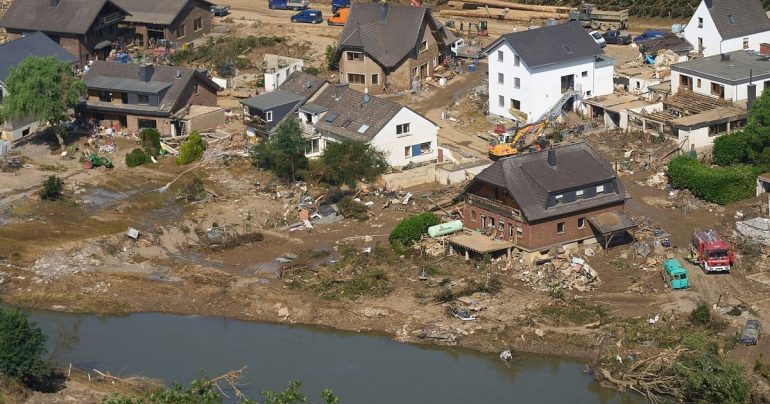GENEVA – How the climate is changing and humans are responsible for it has been described by the Intergovernmental Panel on Climate Change (IPCC) since its first report in 1990.
The sharp rise in temperature and the forecast of disastrous consequences have always frightened you. But then there was a long pause: from 1998 to 2014, there was hardly any change in the global average temperature. Scientists scratch their heads.
“Not that anyone had any doubts about the basics,” says Jochem Marotzke of the Max Planck Institute for Meteorology in Hamburg, the German Press Agency. “But one wonders when an event happens that no one had imagined: where are the limits of our knowledge?” Climate change skeptics were already elated, but then it turned out to be huge.
As the 5th IPCC Assessment Report 2013/2014 was released, the global average temperature increased dramatically. The past six years – 2015 to 2020 – were the warmest since the measurements began. 2016, 2019 and 2020 were the three warmest years with minimal difference. The fact that very little happened between 1998 and 2014 was a normal fluctuation, but statistically an extreme event, says Marotzke, “as you would 6 in a row for “Mensch Argere Dich Nicht”. Wanted to roll eight times.
On August 9, the eagerly awaited first volume of the new status report will be published, which deals with the scientific basis of climate change. This will be finalized in a two-week IPCC meeting from July 26. One thing is already clear: the new report will be different.
“The focus has shifted,” says Douglas Maroun, a German co-author and DPA’s specialist in statistical modeling at the University of Graz in Austria. «The main question used to be: “What is the human contribution to climate change? That question has been answered. Now it’s more in the direction of climate risks. Now you need a report as a basis for adjustment.” This includes, for example, the best possible forecasts for regional climate change.
That’s why the new report includes an interactive regional atlas for the first time. There you can see what the regional effects of certain climate indicators are likely to have at certain times of the year, as Maroun says. It can be divided not on a national level, but in regions such as Central-West Europe, which also includes Germany.
“The summer temperatures here are much higher than what the climate model simulates,” says Maroun. “The role of aerosols and natural fluctuations is being researched.”
Aerosols, which are produced by volcanic eruptions or desert storms, but also from the combustion of fossil fuels, usually have a cooling effect and counteract greenhouse gases. Improvements in air quality since the 1970s have partially eliminated this effect.
In fact, climate change in Germany is more noticeable than average on Earth, for a variety of reasons. Worldwide, temperatures have risen by about 1.1 degrees above pre-industrial levels, in Germany by about 1.6 degrees since 1881, says co-author Astrid Kindler-Schar of Forschungszentrum Jülich.
Other key statistics for Germany: Sunshine period: 17 percent since 1981, Number of warm days: 196 percent since 1951, Days with heavy rains: 5 percent since 1951, Sea level: Since 1843 42 cm in Cuxhaven.
In a climate model of the consequences of the warming of the Mediterranean, more heavy rains were predicted in 2016 for the German region that had experienced a recent flood disaster, ocean researcher Mojib of the Geomer Helmholtz Center for Ocean Research in Kiel said. Latif said. “People are just leaving the climate comfort zone, now it’s getting dangerous,” he said.
Sea level rise will also be a big topic, says co-author Marotzke. “This question is hotly debated in science.” The factors with the greatest uncertainty are the large ice sheets of Greenland and Antarctica and their potential instabilities.
What has happened since the last report? “I can’t think of anything spontaneously where things were less dramatic than what the model predicted,” Maroun says. Still, he was “mildly optimistic”: “While climate protection policy is making a difference, we’re still a long way from going green, but the very dystopian is becoming less likely.” The Paris climate accord goal is “sporty” to stay below 1.5 degrees of warming if possible. He also describes those who are optimistic who assume a temperature of three degrees Celsius.
According to Maraun, one challenge is to shape climate protection in sync with the biosphere. “If you grew rapeseed and energy forests everywhere, you would have protected the climate, but you would destroy biodiversity,” he says.
Marotzke fights with mood-creating activists with doom scenarios: “I have trouble with the concept of a “point of no return,” the point at which the consequences of climate change are irreversible. Of course we’ll lose some things irreversibly , like coral reefs. But when poetry is sung about disaster, it seems that point comes and then the world ends no matter what we do, ”he says. «There is no such thing. It is always worthwhile to prevent or limit further warming.”
© dpa-infocom, dpa: 210725-99-517043 / 3

Web guru. Amateur thinker. Unapologetic problem solver. Zombie expert. Hipster-friendly travel geek. Social mediaholic.





